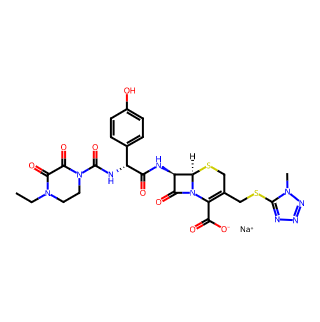- Synthetic anti-infective drugs
- Medications for the digestive system
- Antipyretic and analgesic drugs
- Medications for the blood system
- Medications for the respiratory system
- Anti-allergic drugs
- Medications for the urinary system
- Diagnostic medications
- Immunosuppressive and immunomodulatory drugs
- Vitamins and mineral supplements
- Antioxidants and medications for osteoporosis
- Antiparasitic drugs
- Ophthalmic medications
- Amino acids and their derivatives
- Dermatological medications
- Medications for the circulatory system
- Antitumor drugs
- Medications for the nervous system
- Hormonal and endocrine function-regulating drugs
- Antibiotics
- Others
CAS Number: 62893-20-3




I. Basic Information
Product Name: Cefoperazone sodium
CAS Number: 62893-20-3
Molecular Formula: C25H26N9NaO8S2 (note: there may be slight variations in molecular formula representations, but this is the most commonly used one)
Molecular Weight: Approximately 667.65 (the specific value may vary slightly depending on the source)
II. Physical Properties
Appearance: White to off-white powder or crystalline powder
Odor: Odorless
Hygroscopicity: It is hygroscopic
Solubility: Soluble in water, slightly soluble in alcohol, and insoluble in acetone or ethyl acetate
Melting Point: Ranges from 200°C to 202°C
III. Chemical Properties
Stability: Cefoperazone sodium is relatively stable, and its aqueous solution degradation follows first-order kinetics.
IV. Pharmaceutical Characteristics
Antibacterial Spectrum: Cefoperazone sodium is a third-generation cephalosporin with broad-spectrum antibacterial activity. It is sensitive to most Gram-negative bacteria, including Escherichia coli, Klebsiella pneumoniae, Proteus mirabilis, Salmonella typhi, Shigella, and Citrobacter species. It also has good antibacterial activity against Pseudomonas aeruginosa. Additionally, it is effective against Streptococcus pneumoniae, Streptococcus hemolyticus, and other streptococci. However, it has only moderate activity against Staphylococcus aureus (methicillin-sensitive strains) and is resistant to Enterococcus species.
Indications: Cefoperazone sodium is used for the treatment of various infections caused by sensitive bacteria, such as respiratory infections, urinary tract infections, biliary tract infections, skin and soft tissue infections, sepsis, peritonitis, pelvic infections, and other infections. For the latter two indications, it is often used in combination with anaerobic antibacterial drugs.

Tai Yau Street, San Po Kong, Kowloon, Hong Kong, China.



